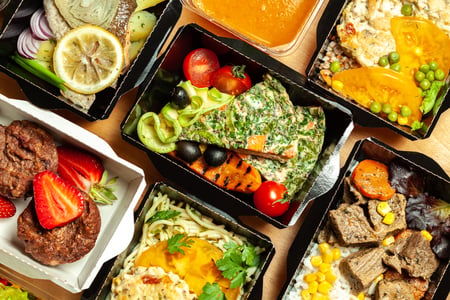In a year’s time, ghost kitchens went from novelty to industry mainstay. Experts now believe they’re a permanent part of the foodservice industry.

Ghost or virtual kitchens, in which a commercial kitchen produces food exclusively for delivery, can take a few different forms. Some ghost kitchens operate in shared or commissary kitchens. Others exist in the back of an existing restaurant, which could offer Italian specialties for the dine-in crowd and sub sandwiches for delivery.
Market research firm Euromonitor predicts ghost kitchens will grow into a $1 trillion industry by 2030, as delivery grabs market share from takeout, drive-thru and other segments. But does it make sense to adopt this model when everyone else is jumping on board? We’ll take a close look at the pros and cons.
The Advantages of Operating a Ghost Kitchen
You can test a new niche.
If there’s an underserved daypart or consumer desire, a virtual-kitchen model can profit from it. Dog Haus, based in Pasadena, California, is a well-established chain known for high-quality hot dogs and sausages. But the operators realized they could do more business by diversifying, so they launched virtual brands for chicken sandwiches, burgers and breakfast burritos.
The shift paid off for franchisees in a big way. “Systemwide, same-store sales were up 110% May, June and July [2020] compared to that same time frame in 2019,” Restaurant Dive reports.
Ghost kitchens can suppress costs.
It’s much cheaper to open a virtual kitchen than to outfit a full-service restaurant. A desirable location doesn’t matter, so an operator can seek low-rent space. There are no expenses for interior design or dining room furnishings.
Whether you’re launching a ghost kitchen from scratch or beginning virtual operations in an existing restaurant, come to Hamilton Beach Commercial for the affordable, high-quality commercial kitchen equipment you need. Must-haves (depending on the menu) include a high-performance blender, a commercial immersion blender, a vacuum packaging machine, and an immersion circulator for cooking sous vide.
Virtual kitchens can keep hotel kitchens busy during slow periods.
The model has proved a good fit for underused hotel kitchens, which are typically set up to accommodate caterers and other third parties. “Hotels see this as a profit center,” Frederick DeMicco, executive director of Northern Arizona University’s School of Hotel and Restaurant Management, told The New York Times. “It supplements the existing menu options at the hotel, and extends well-respected restaurant brands as partners in the hotel. Consumers recognize and approve of that.”
The U.S. boutique chain Graduate Hotels recently partnered with C3 (Creating Culinary Communities) to launch Graduate Food Hall: a digital kitchen concept that fulfills orders for up to six C3 brands, both for delivery and for onsite hotel dining. A guest can order a vegan Seoul Food Bowl from Plant Nation and a craft coffee from EllaMia and have both delivered by the hotel kitchen in minutes.
You can let someone else do the marketing.
One headline-grabbing aspect of ghost kitchens is the advent of pop-up celebrity food brands. Customers all over the United States, for instance, can order singer Mariah Carey’s cookies, rapper Tyga's baked chicken bites, or “Jersey Shore” reality star Pauly D’s subs — all the creations of Virtual Dining Concepts. The company offers to handle all training, marketing and setup, with no upfront fees, in exchange for a portion of profits.
The Disadvantages of Operating a Ghost Kitchen
Beware brand dilution.
Tamarind, a well-regarded Indian restaurant in Norfolk, Virginia, received an offer from a ghost-kitchen broker: The broker would sell Tamarind’s dishes in the same market, at a markup, under a new name, Gunpowder Café. It worked well, Tamarind’s owner said: They’ve reached new customers and received a few extra orders every day from the arrangement, while paying the company a fee.
However, this model might not work for every restaurant. If customers catch on, they may be unhappy that they’re paying extra for the same food they could order directly from you. Be careful not to become your own competitor.
Delivery costs and logistics can be a challenge.
Third-party delivery companies typically charge fees of 15% to 30% for delivery, payment processing, marketing and commissions. While this may be changing — GrubHub recently introduced a no-commission option — operators must do the math to determine if delivery-only is a sustainable model.
There are also inventory costs to consider. Do you need custom-printed packaging? Or can you slap a sticker on the bag? Do customers expect high-quality, sustainable food containers? Can you ensure food quality remains high through the delivery process?
Data is everything.
What are diners searching for in your local area? Which types of foods have hit the saturation point? Will delivery-app algorithms place you at the top of search results for “pad thai”? Or 17th for “spring rolls”?
"While the off-premise market is booming, especially during this time, no brand can simply start up delivery and takeout and expect it to be a huge and immediate success," Joy Lai, chief operating officer at Kitchen United, tells Restaurant Dive. Start with a thoughtful strategy before leaping in.
Hamilton Beach Commercial is here to support our foodservice and hospitality clients during this tumultuous time. Our hard-working commercial kitchen equipment is built to keep up with your business as it grows.


